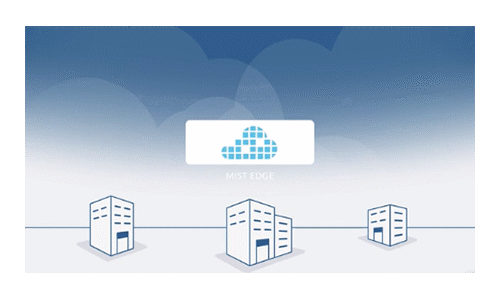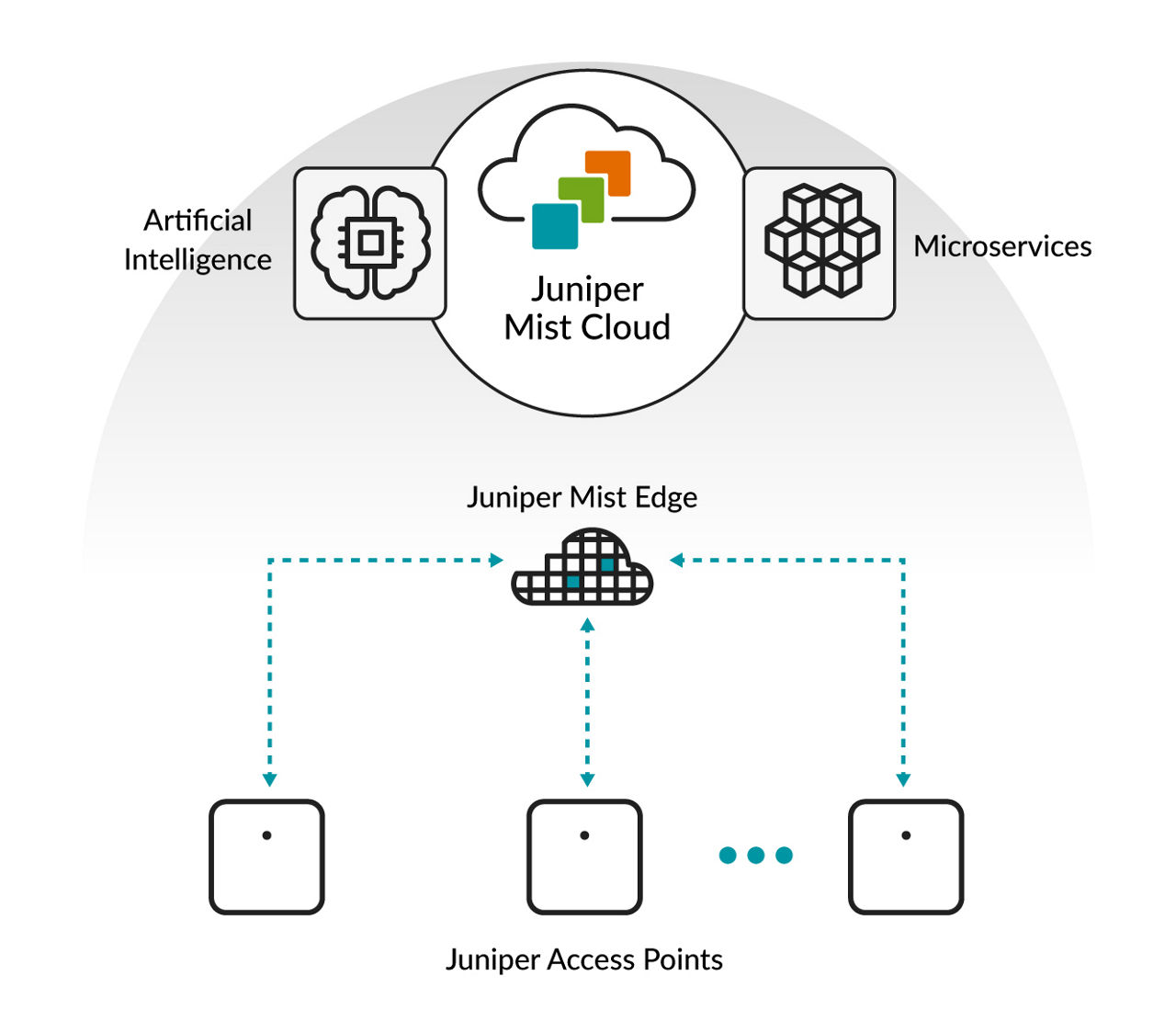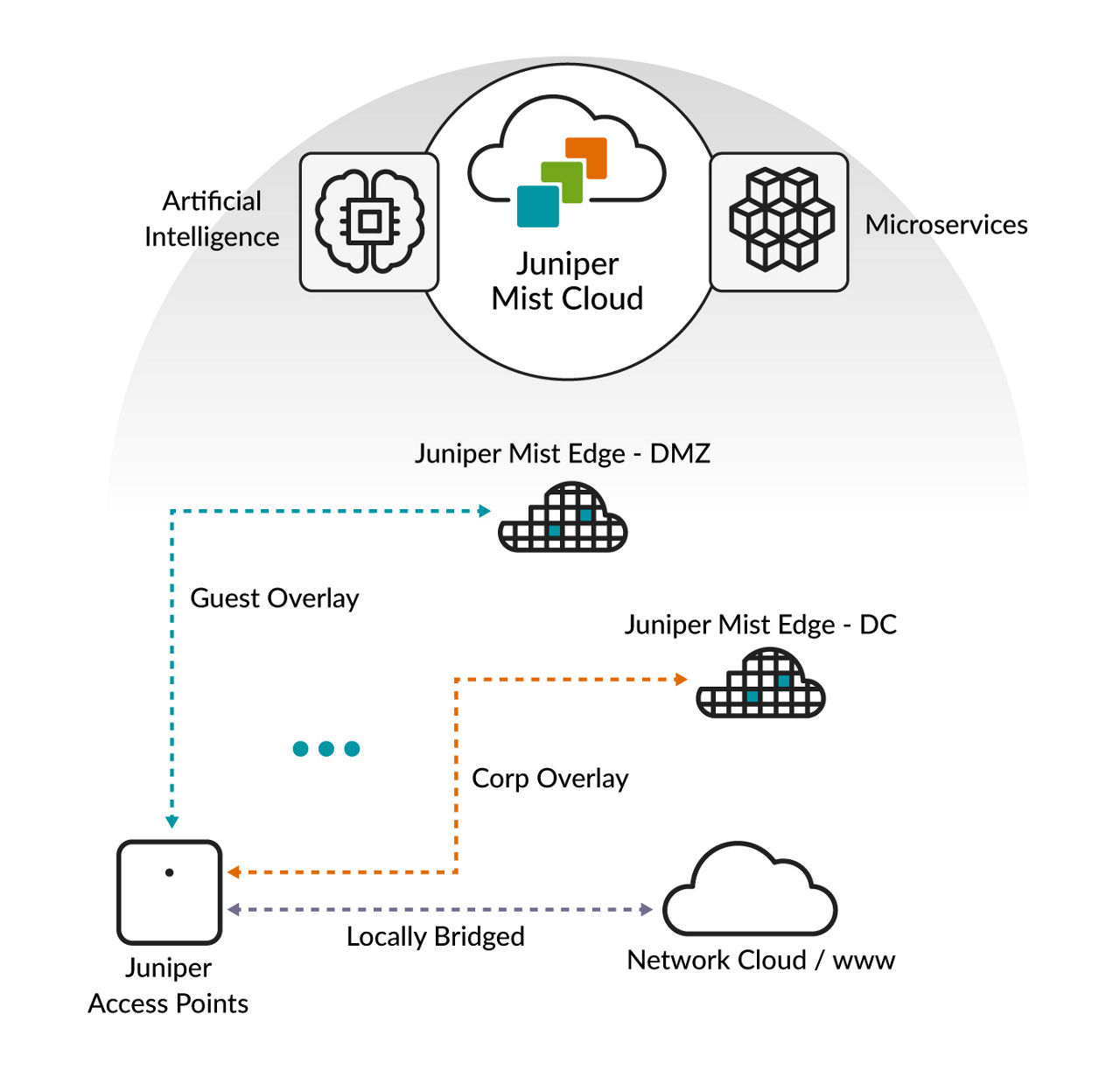Juniper Mist Edge 데이터시트
데이터시트 다운로드제품 개요
Juniper Mist Edge는 마이크로서비스를 캠퍼스 네트워크로 확장하여 민첩성과 확장성을 제공하는 동시에 에지 환경에서 새로운 애플리케이션을 지원합니다. Juniper Mist Edge는 Juniper Mist Cloud와 분산형 소프트웨어 아키텍처를 사용하여 다음을 제공합니다.
— 확장 가능하고 복원력이 뛰어난 운영
— 관리
— 문제 해결
— 분석

제품 설명
Juniper® Mist™ Edge는 레거시 무선 컨트롤러 없이 AI 네이티브 무선의 민첩성과 확장성을 캠퍼스 에지로 확장합니다. Juniper Mist Edge는 데이터 중앙화를 지원해, 레거시 네트워크 설계의 제약을 극복하려는 조직과 게스트 및 원격 액세스를 위한 끊김 없는 무선 모빌리티를 원하는 조직에 유용합니다.
Juniper Mist Edge를 사용하는 조직은 Juniper Mist™ 마이크로서비스 클라우드와 Marvis® AIOps를 활용해 로컬화된 데이터를 분석할 수 있습니다. 이 고유한 조합은 간단하고 원활한 대규모 캠퍼스 로밍과 동적 세그멘테이션이 가능한 보안 IoT를 지원하는 동시에 민첩성과 안정성, 운영 단순성을 제공합니다. 주니퍼의 AI 네이티브 네트워킹(AI-Native Networking) 플랫폼인 Mist는 전례 없는 수준의 자동화와 인사이트를 통해 IT 운영을 간소화합니다.
Juniper Mist Edge를 사용하는 조직은 필요에 따라 캠퍼스에 새로운 마이크로서비스와 업그레이드를 손쉽게 구축할 수 있습니다. 원하는 네트워크 서비스를 원하는 위치에 일관적이고 원활하며 안전한 방식으로 구축하고 관리할 수 있습니다.
Juniper Mist Edge 사용 사례
Juniper Mist Edge는 네트워크의 유연성과 운영 효율성을 높이는 동시에 무선과 관련된 여러 가지 문제를 해결합니다. Mist Edge는 기업에 다음과 같은 도움을 줍니다.
- 기존 네트워크 설계에 영향을 주지 않고 기존 컨트롤러 아키텍처에서 최신 마이크로서비스 클라우드로 손쉽게 전환
- 캠퍼스에서 마이크로서비스를 확대하여 확장 가능하고 복원력이 뛰어난 무선 운영, 관리, 문제 해결 및 분석 구현
- 분산된 브랜치와 재택근무자에게로 VLAN을 확장하여 원격 VPN 기술 대체
- 게스트 액세스와 기업 트래픽 분리
- IoT 디바이스용 동적 트래픽 세그멘테이션 제공
Mist, 주니퍼의 AI 네이티브 네트워킹(AI-Native Networking) 플랫폼
유선 및 무선 네트워크는 비즈니스에 필수적이지만, 적절한 아키텍처가 없다면 현재 사용 중인 다양한 하드웨어, 운영 체제, 애플리케이션은 물론, 수많은 모바일 및 IoT 디바이스로 인해 운영이 보다 어려워질 수 있습니다. 수작업 및 네트워크 중심의 기존 아키텍처는 최신 모빌리티 요구사항을 지원하는 데 필요한 확장성, 유연성, 엔드투엔드 가시성이 부족해 이를 관리하는 IT 부서의 부담을 가중시킵니다.
주니퍼의 AI 네이티브 네트워킹(AI-Native Networking) 플랫폼인 Mist는 고유한 서비스 수준 기대치(SLE) 메트릭을 통해 사용자 경험에 대한 전례 없는 수준의 가시성을 제공하여 예측 가능하고 안정적이며 측정 가능한 Wi-Fi를 구현합니다. 선제적인 AI 네이티브 자동화와 자가 치유 네트워크는 시간 소모적인 수동 설정 작업을 대체하여 Wi-Fi 운영 비용을 절감하고 상당한 시간과 비용을 절약합니다. 주니퍼 액세스 포인트와 Juniper Mist Edge는 Juniper Mist Cloud가 관리합니다. 이 시스템은 최고의 네트워크 확장성과 성능을 제공하고, WLAN 및 위치 서비스에 DevOps의 민첩성을 더합니다.
Juniper Mist Cloud는 네트워크에 탁월한 민첩성, 확장성, 복원력을 제공합니다. 또한 이 제품은 데이터 사이언스를 사용하여 주니퍼 액세스 포인트가 수집한 많은 양의 풍부한 메타데이터를 분석함으로써 OpEx를 절감하고 네트워크 성능, 동작, 트래픽 패턴 및 잠재적 문제 지점에 대한 전례 없는 인사이트를 제공합니다.
주니퍼 액세스 포인트 제품군
Juniper Mist Edge
일부 네트워크 서비스는 대역폭, 지연 또는 아키텍처 요건 때문에 특정 기능을 온프레미스에서 처리해야 합니다. Juniper Mist Edge는 일부 마이크로서비스를 고객 온프레미스로 확장하면서도 Juniper Mist Cloud와 분산형 소프트웨어 아키텍처를 활용해 확장 가능하고 복원력이 뛰어난 운영, 관리, 문제 해결 및 분석을 지원합니다.
대규모 캠퍼스 네트워크의 경우, Juniper Mist Edge는 액세스 포인트와 주고받는 트래픽의 온프레미스 터널 종료를 통해 데이터 플레인 중앙화와 원활한 로밍을 제공하고, 모든 제어 및 관리 기능은 Juniper Mist Cloud에 유지합니다.
Juniper Mist Edge는 VLAN을 분산된 브랜치와 재택근무자에게로 확장하여 원격 VPN 기술을 대체하고, IoT 디바이스용 동적 트래픽 세그멘테이션을 제공합니다. 분할 터널링을 통해서는 게스트 액세스와 기업 트래픽을 분리할 수 있습니다.
Juniper Mist Edge 아키텍처는 다음과 같은 주요 이점을 제공합니다.
- 새로운 마이크로서비스를 신속하게 개발 및 구축할 수 있는 민첩성
- 소규모 및 대규모 캠퍼스의 수요를 모두 충족할 수 있는 확장형 플랫폼
- 구축 및 관리 간소화
- 신속한 페일오버를 위한 무상태 아키텍처
- 몇 초 만에 가능한 서비스 업그레이드
- AP 펌웨어와 서비스 구축 분리
- 제로터치 구성 및 클라우드 관리

그림 1: Juniper Mist Edge를 활용한 AI 네이티브 엔터프라이즈 솔루션
Juniper Mist Edge는 독립형 어플라이언스로 구축되며, 다양한 규모의 구축에 맞는 다양한 버전이 제공됩니다. 소프트웨어 전용 가상 머신(VM) 솔루션을 활용하여 설계 유연성을 높일 수도 있습니다.
기능 및 이점
터널링 마이크로서비스
이 서비스를 사용하면 네트워크 설계에 영향을 주지 않고 레거시 컨트롤러 아키텍처의 기존 중앙 집중식 데이터 플레인에서 최신 Juniper Mist 마이크로서비스 클라우드로 원활하게 전환할 수 있습니다.
AP는 재택근무자 시나리오에서 지정된 WLAN에 한해 표준 기반 L2TPv3 기술 또는 IPsec을 사용하여 Juniper Mist Edge와 주고받는 트래픽을 터널링합니다. 이 기능은 필요에 따라 분산형과 중앙 집중형 데이터 플레인을 조합해 고객의 요구사항을 충족할 수 있는 네트워크 설계 유연성을 제공합니다. Juniper Mist Edge 구축 환경에서는 로컬 브리지 및 터널링 WLAN을 모두 지원할 수 있습니다.
이 서비스를 사용하면 Mist 마이크로서비스 클라우드 아키텍처로 전환하는 동안에도 에지 스위치의 VLAN 구성을 유지할 수 있습니다. 이를 위해서는 중앙 집중식 Juniper Mist Edge 디바이스 클러스터를 통해 트래픽을 터널링하면서도 SSID와 사용자를 별도의 VLAN으로 분리하는 기능을 유지해야 합니다.
또한 이 서비스는 지연 민감형 애플리케이션을 실행하는 디바이스에 끊김 없는 모빌리티를 제공하므로, 캠퍼스 내 이동 중에도 성능을 유지할 수 있습니다. Juniper Mist Edge 클러스터는 지능적 운영을 통해 브로드캐스트 및 멀티캐스트 트래픽 전송을 최적화하여 확장 가능하고 안정적인 성능을 제공합니다.
또한 Juniper Mist Cloud와 제로터치 프로비저닝 기능은 터널 구성을 간소화합니다.

그림 2: 주니퍼 액세스 포인트의 다중 터널
터널링된 WLAN과 유연한 트래픽 리디렉션
Wi-Fi를 구축할 때는 WLAN을 로컬로 브리징하는 동시에 게스트 액세스 및 기업 무선 네트워크 트래픽을 위한 별도의 오버레이를 지원해야 하는 경우가 많습니다. Juniper Mist 마이크로서비스 아키텍처는 무선 구성 요구사항에 따라 서로 다른 Juniper Mist Edge 어플라이언스로 다중 터널을 형성할 수 있는 유연성을 제공합니다. 예를 들어, WLAN의 한 사이트는 로컬로 브리징하고 게스트 WLAN은 DMZ(Juniper Mist Edge)로 터널링하며 회사 SSID는 회사 리소스 액세스를 위해 데이터센터(Juniper Mist Edge)로 터널링할 수 있습니다.
고가용성과 클러스터링
Juniper Mist Edge는 노드 수 제한 없이 확장 가능한 탄력적인 클러스터(백업 클러스터 옵션 포함)를 지원합니다. 터널링 마이크로서비스용 Juniper Mist Edge 클러스터 설계는 AP 수, 클라이언트 수, 처리량 예상치에 기반한 총용량을 고려하여 결정됩니다.
액티브/액티브 터널링 클러스터는 전통적인 N+1 스탠바이 아키텍처보다 더 높은 가용성과 복원력을 제공하고 중복을 보장하는 동시에, 유휴 용량이 없도록 Mist Edge 간에 AP를 균형 있게 분산시킵니다. Mist Edge는 치명적인 네트워크 장애 발생 시에도 WLAN 생존성을 보장하기 위해 다층의 중복을 지원합니다. 클러스터 내의 여러 Mist Edge 노드 덕분에 AP는 장애 발생 시 어떤 생존 노드에도 연결될 수 있습니다. 데이터센터 내의 전체 클러스터가 오프라인 상태가 되더라도, Mist AP는 다른 데이터센터에 호스팅된 클러스터로 페일오버하여 네트워크 생존성을 보장할 수 있습니다.
또한 Mist Edge 아키텍처의 유연성을 통해 한 사이트의 스탠바이 클러스터를 다른 사이트의 기본 클러스터로 지정해 리소스 활용도를 극대화하고 운영 비용을 절감할 수도 있습니다.
주니퍼 AP는 제어 및 관리 기능을 데이터 플레인에서 분리해, Mist Edge와의 연결이 끊어져도 계속해서 작동할 수 있습니다.
Access Assurance Proxy
Access Assurance Proxy를 탑재한 Juniper Mist Edge는 서드파티 네트워크 디바이스와 Juniper Mist Cloud 간의 보안 인증 게이트웨이 역할을 합니다. Mist Edge를 통해 RADIUS 인증 요청을 프록시함으로써, 조직은 비 주니퍼 인프라에서도 보안 RadSec 터널을 사용하여 클라우드 기반 액세스 정책과 디바이스 인증을 강제할 수 있습니다. 이러한 접근 방식은 ID 관리를 간소화하고, 네트워크 가시성을 강화하며, 확장 가능한 중앙 집중식 정책 시행을 보장하여 보안과 운영 효율성을 향상합니다.
어플라이언스 모델 및 사양
| 모델 | 최대 AP/클라이언트/처리량 | 인터페이스 |
| ME-VM | 500/5,000/2Gbps | 듀얼 포트 1GbE(데이터) 및 듀얼 포트 1GbE(관리) |
| ME-X1-M | 500/5,000/4Gbps | 쿼드 포트 1GbE(데이터) 및 듀얼 포트 1GbE(관리) |
| ME-X2-M | 2,000/20,000/40Gbps | 쿼드 포트 10GbE SFP+(데이터) 및 듀얼 포트 1GbE(관리) |
| ME-X6 | 5,000/100,000/100Gbps | 쿼드 포트 25GbE SFP28(데이터) 및 쿼드 포트 25GbE SFP28(관리) |
귀사의 AI 기반 엔터프라이즈에 Juniper Mist Edge가 적합한지 여부를 평가하려면, 차세대 네트워크 설계를 지원할 수 있는 현지 주니퍼 파트너 또는 담당자에게 문의하시기 바랍니다.
주문 정보
| 부품 번호 | 설명 |
| 어플라이언스 | |
| ME-X1-M | Mist Edge 어플라이언스, 4x1Gbps, AP 500개 지원 |
| ME-X2-M | Mist Edge 어플라이언스, 4x10GBASE-X(SFP+), AP 2000개 지원 |
| ME-X6 | Mist Edge 어플라이언스, 4x25GBASE-XX(SFP28), AP 5000개 지원 |
| 가상 | |
| ME-VM | Mist Edge VM, AP 500개 지원 |
| ME-VM-OC-PROXY | 프록시용 Mist Edge VM(터널링 없음) |
| 구독 | |
| S-ME-S-x | SW, Mist Edge Assurance(SUB-ME) 표준, AP당 구독 |
| 연장 보증 | |
| ME-ADV-XCH-xx | Mist Edge용 연간 확장 하드웨어 지원 |
보증에 관한 정보는 https://support.juniper.net/ sites/support/pdf/warranty/juniper-mist-wifi-warranty.pdf를 참고하세요.
| ME-X1-M | |
| 크기 및 전력 | |
| 폼 팩터 | 1U(2포스트 및 4포스트 랙용 1U/2U 고정 레일 포함) |
| 크기(너비 x 깊이 x 높이) | 17.1인치(너비) x 22.2인치(깊이) x 1.69인치(높이) |
| 무게 | 12.48kg(27.51파운드) |
| 전원 공급 장치 | 단일 케이블 전원 공급 장치, 450W, 100–240V AC, 자동 전압 조정, 50/60Hz, 6.5-3.5Amp |
| 최대 전력 소모(예상) | 387.5와트 |
| 유휴 전력 소모(예상) | 134와트 |
| 열 방산(최대) | 1725BTU/시간 |
| 전원 코드 | 인증을 받은 모든 국가용으로 제공됩니다 기본 - NEMA 5-15P to C13 벽면 플러그, 125V, 15A, 10피트(3m) 전원 코드, 북미 |
| 환경 매개변수 | |
| 표준 작동 온도 | 10~35°C(50~95°F) |
| 주변 온도 제한 | 30°C |
| 장애 간 평균 시간(MTBF) | 170,000시간 |
| ME-X2-M | |
| 크기 및 전력 | |
| 폼 팩터 | 1U(2포스트 및 4포스트 랙용 1U/2U 고정 레일 포함) |
| 크기(너비 x 깊이 x 높이) | 17.1인치(너비) x 18.16인치(깊이) x 1.69인치(높이) |
| 무게 | 9.44kg(20.81파운드) |
| 전원 공급 장치 | 단일 케이블 전원 공급 장치, 450W, 100–240V AC, 자동 전압 조정, 50/60Hz, 6.5-3.5Amp |
| 최대 전력 소모(예상) | 176와트 |
| 유휴 전력 소모(예상) | 95와트 |
| 열 방출(최대) | 1730BTU/시간 |
| 전원 코드 | 인증을 받은 모든 국가용으로 제공됩니다 기본 - NEMA 5-15P to C13 벽면 플러그, 125V, 15A, 10피트(3m) 전원 코드, 북미 |
| 환경 매개변수 | |
| 표준 작동 온도 | 10~35°C(50~95°F) |
| 주변 온도 제한 | 30°C |
| 장애 간 평균 시간(MTBF) | 122,000시간 |
| ME-X6 | |
| 크기 및 전력 | |
| 폼 팩터 | 1U(2포스트/4포스트 랙용 Ready Rails 슬라이딩 레일 포함) |
| 크기(너비 x 깊이 x 높이) | 18.98인치(너비) x 18.8인치(깊이) x 1.69인치(높이) |
| 무게 | 13.6kg(29.9파운드) |
| 전원 공급 장치 | 듀얼 핫플러그 이중화 전원 공급 장치(1+1), 800W, 100–240V AC, 자동 전압 조정, 50/60Hz, 6.5A-3.5A |
| 최대 전력 소모(예상) | 490와트 |
| 유휴 전력 소모(예상) | 105와트 |
| 열 방출(최대) | 3139BTU/시간 |
| 전원 코드 | 인증을 받은 모든 국가용으로 제공됩니다. 기본 - 전원 코드 - C13, 3M, 125V, 15A(북미, 괌, 북마리아나 제도, 필리핀, 사모아, 베트남) |
| 환경 매개변수 | |
| 표준 작동 온도 | -5~55°C(23~131°F) |
| 주변 온도 제한 | 55°C |
| 장애 간 평균 시간(MTBF) | 231,000시간 |
주니퍼 네트웍스에 대하여
주니퍼 네트웍스는 AI와 네트워킹의 컨버전스를 선도하고 있습니다. 주니퍼의 Mist™ AI 네이티브 네트워킹(AI-Native Networking) 플랫폼은 AI 워크로드를 실행하고 IT 운영을 간소화하도록 특별히 설계되어 에지부터 데이터센터, 클라우드에 이르기까지 탁월하고 안전한 사용자 및 애플리케이션 경험을 보장합니다. 추가 정보는 www.juniper.net, X, LinkedIn, Facebook에서 확인할 수 있습니다.
1000749 - 007 - EN 2025년 9월

















